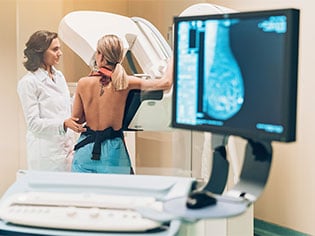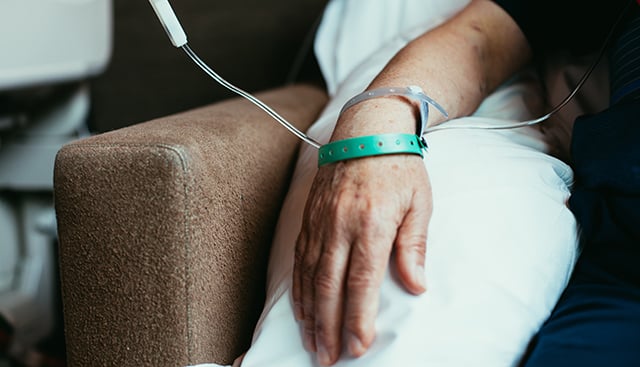Invasive Ductal Carcinoma

Comprising around 80% of breast cancer cases, invasive ductal carcinoma (IDC) is the most common form of breast cancer. In IDC, cancerous cells initially form in a duct that carries milk from the milk-producing lobules to the nipple. The cancer becomes "invasive" when it penetrates the walls of the milk duct and spreads to the surrounding breast tissue and lymph nodes, or when it travels through the bloodstream or lymphatic system to other areas of the body.
What causes invasive ductal carcinoma?
Researchers know that invasive ductal carcinoma occurs when cells in a duct undergo changes that trigger rapid and abnormal cell division, or when cells exceed their normal lifespan. The exact causes of these unusual cellular behaviors are not yet fully understood by scientists.
Anyone—including men—can develop breast cancer. However, clinical data shows that IDC and other types of breast cancer are more likely to affect women who:
- Are older (breast cancer risk increases with age)
- Previously received radiation treatment to the chest
- Have a family history of breast cancer
- Have certain inherited gene mutations, such as BRCA1 or BRCA2
- Have a personal history of breast conditions, such as lobular carcinoma in situ (LCIS)
- Are overweight or obese
- Use oral contraceptives
- Drink alcohol
- Have never been pregnant
- Become pregnant for the first time after age 30
There is no definitive way to prevent IDC or any cancer; however, implementing these healthy lifestyle habits may help lower cancer risk:
- Quit smoking and other forms of tobacco use
- Lose excess body weight
- Regularly engage in physical activity
- Avoid or limit alcohol consumption
- Maintain a nutrient-rich diet and limit consumption of processed meats
What are the symptoms of invasive ductal carcinoma?
 Invasive ductal carcinoma may not cause any signs or symptoms in its initial stages. As the disease progresses, it may produce:
Invasive ductal carcinoma may not cause any signs or symptoms in its initial stages. As the disease progresses, it may produce:
- A breast lump
- A lump in the underarm area
- Thickening of breast skin
- Breast skin that is dimpled, similar to an orange peel
- Redness, dryness or a rash on the breast skin
- Unusual pain in one breast
- Nipple pain and/or discharge
Many breast changes are unrelated to cancer and are not a cause for concern. However, diagnostic testing is necessary to rule out IDC and other breast malignancies. Women who notice an unusual lump or changes in their breast skin should promptly consult with a medical professional who can identify the cause of their symptoms and recommend appropriate treatment.
How is invasive ductal carcinoma diagnosed?
Diagnosing invasive ductal carcinoma often begins with a breast exam, during which a clinician will look and gently feel for irregularities around the breast, collarbones and underarms. If a lump is found or cancer is suspected, one or more of the following tests may be recommended:
- A mammogram to take an X-ray image of the breast
- A breast ultrasound to capture images of breast tissue using sound waves
- A magnetic resonance imaging (MRI) scan to generate images of breast tissue using radio waves (no radiation is used)
- A biopsy to collect a small sample of breast cells using an X-ray-guided needle
What does invasive ductal carcinoma treatment involve?

Treatment for invasive ductal carcinoma will vary based on factors like the patient’s age, overall health and care preferences as well as the cancer’s stage and biological makeup. Generally speaking, many IDC treatment plans include a combination of one or more of the following:
- Surgery to remove tumors, cancerous breast tissue or surrounding lymph nodes
- Radiation therapy to damage cancer cells with high-powered, precisely delivered X-ray beams
- Chemotherapy to attack cancer cells throughout the body with potent medication
- Targeted therapy to disturb various processes that facilitate cancer growth
- Hormonal therapy to address IDC that tests positive for hormone receptors
- Immunotherapy to help the immune system recognize cancer and disrupt its growth
Advancements in breast cancer treatment have improved the outlook for patients with IDC. When diagnosed in an early stage, IDC is considered highly treatable.
Our approach to invasive ductal carcinoma
The Don & Erika Wallace Comprehensive Breast Program at Moffitt Cancer Center offers patients access to a multispecialty team that focuses exclusively on diagnosing and treating breast cancer, including invasive ductal carcinoma. As a high-volume cancer center, our fellowship-trained surgeons, medical oncologists, pathologists, radiologists, radiation oncologists, plastic surgeons, breast reconstruction experts, social workers, genetic testing and counseling specialists and other healthcare professionals have extensive experience that cannot be matched by most other providers. Our unrivaled expertise consistently leads to better outcomes and enhanced quality of life for our patients.
A recognized leader in the treatment of invasive ductal carcinoma and other forms of breast cancer, Moffitt has earned an outstanding international reputation based on our:
- Unique, multispecialty approach to cancer treatment
- Highly individualized treatment plans
- State-of-the-art equipment and technology
- Advanced surgical techniques
- Convenient location for all patient services and support
- Groundbreaking research and robust clinical trials
At Moffitt, the road to outstanding breast cancer treatment is well traveled, and our compassionate experts are available to provide all of the guidance and support you need to make the important decisions that lie ahead. For information about diagnostic and treatment options for invasive ductal carcinoma, call 1-888-663-3488 or complete a new patient registration form online. We understand the significance of prompt response times and will connect you with a cancer specialist rapidly.
